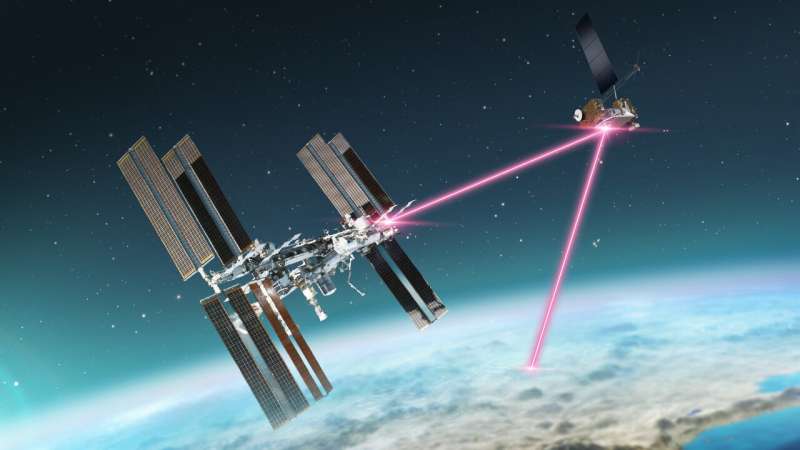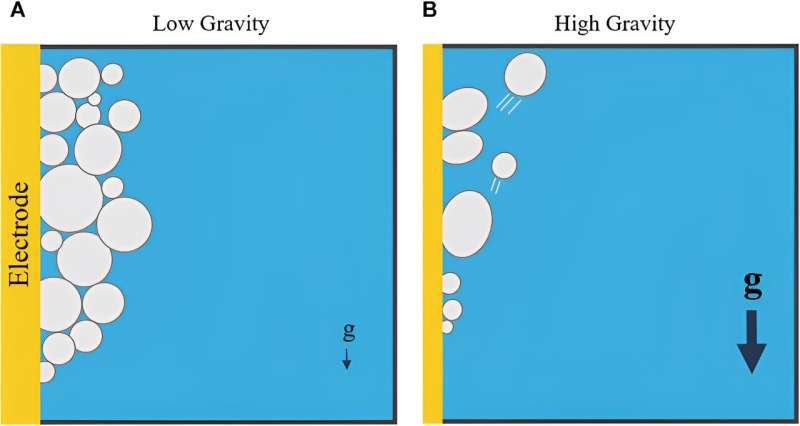Chinese lunar probe finds water in Moon samples
Wednesday, 24 July 2024 22:17 A Chinese lunar probe found traces of water in samples of the Moon's soil, scientists have said, as the country pushes its ambitious space programme into high gear.
The Chang'e-5 rover completed its mission in 2020, returning to Earth with rock and soil samples from the Moon.
The lunar samples "revealed the presence of trace water", the group of scientists from Chinese universities wrote
A Chinese lunar probe found traces of water in samples of the Moon's soil, scientists have said, as the country pushes its ambitious space programme into high gear.
The Chang'e-5 rover completed its mission in 2020, returning to Earth with rock and soil samples from the Moon.
The lunar samples "revealed the presence of trace water", the group of scientists from Chinese universities wrote Stellar magnetism may influence exoplanet habitability
Wednesday, 24 July 2024 22:17 The pursuit of discovering life beyond our solar system has heightened interest in Earth-like planets within the habitable zone of their stars. However, the habitability of these exoplanets is affected by more than just their distance from the star.
A new study by Rice University's David Alexander and Anthony Atkinson broadens the definition of a habitable zone to include the star's magnet
The pursuit of discovering life beyond our solar system has heightened interest in Earth-like planets within the habitable zone of their stars. However, the habitability of these exoplanets is affected by more than just their distance from the star.
A new study by Rice University's David Alexander and Anthony Atkinson broadens the definition of a habitable zone to include the star's magnet Solar storm may cause northern lights to be visible from New York to Idaho
Wednesday, 24 July 2024 22:17 A solar storm could bring the northern lights to the northern United States this week, the National Oceanic Atmospheric Administration said.
The NOAA's Space Weather Prediction Center issued a G2 geomagnetic storm watch for early Wednesday.
It said the northern lights or aurora borealis, as the phenomenon is known in the Northern Hemisphere, could become visible above "some north
A solar storm could bring the northern lights to the northern United States this week, the National Oceanic Atmospheric Administration said.
The NOAA's Space Weather Prediction Center issued a G2 geomagnetic storm watch for early Wednesday.
It said the northern lights or aurora borealis, as the phenomenon is known in the Northern Hemisphere, could become visible above "some north NASA funds research on orbital debris and Lunar sustainability
Wednesday, 24 July 2024 22:17 To support responsible space exploration, NASA's Office of Technology, Policy, and Strategy (OTPS) is sponsoring research from five university teams. These teams will examine critical economic, social, and policy issues related to Earth's orbit and cislunar space.
This initiative aligns with NASA's Space Sustainability Strategy, aimed at promoting safe and sustainable space activities for
To support responsible space exploration, NASA's Office of Technology, Policy, and Strategy (OTPS) is sponsoring research from five university teams. These teams will examine critical economic, social, and policy issues related to Earth's orbit and cislunar space.
This initiative aligns with NASA's Space Sustainability Strategy, aimed at promoting safe and sustainable space activities for UAH Teams shine in 2024 International CanSat Competition
Wednesday, 24 July 2024 22:17 Three teams from The University of Alabama in Huntsville's (UAH) Space Hardware Club (SHC) have achieved top national rankings in the 2024 International CanSat competition. The UAH student teams Shockwave, Snapdragon, and Moonracer secured first, third, and fourth places nationally and second, seventh, and tenth places internationally.
"The accomplishment is even more impressive considerin
Three teams from The University of Alabama in Huntsville's (UAH) Space Hardware Club (SHC) have achieved top national rankings in the 2024 International CanSat competition. The UAH student teams Shockwave, Snapdragon, and Moonracer secured first, third, and fourth places nationally and second, seventh, and tenth places internationally.
"The accomplishment is even more impressive considerin SmartSat CRC and NZ Govt unveil collaborative space research projects
Wednesday, 24 July 2024 22:17 SmartSat Cooperative Research Centre (SmartSat CRC) has announced the commencement of four new space research projects jointly funded with New Zealand's Ministry of Business, Innovation and Employment (MBIE), starting in August 2024. These initiatives mark the first phase of the Australia-New Zealand Collaborative Space Program and include projects on methane emissions monitoring, real-time gree
SmartSat Cooperative Research Centre (SmartSat CRC) has announced the commencement of four new space research projects jointly funded with New Zealand's Ministry of Business, Innovation and Employment (MBIE), starting in August 2024. These initiatives mark the first phase of the Australia-New Zealand Collaborative Space Program and include projects on methane emissions monitoring, real-time gree Designing space exploration with the human in mind
Wednesday, 24 July 2024 22:17 When designing a new spacecraft or exploration vehicle, there is intense focus on its technical performance. Do its systems perform as expected? What kind of power does it need? Will it safely reach its destination?
Equally important, however, is whether that vehicle also works for the humans inside. Can astronauts easily reach critical controls? Do the seats conform to a crew member regar
When designing a new spacecraft or exploration vehicle, there is intense focus on its technical performance. Do its systems perform as expected? What kind of power does it need? Will it safely reach its destination?
Equally important, however, is whether that vehicle also works for the humans inside. Can astronauts easily reach critical controls? Do the seats conform to a crew member regar Morpheus Space unveils new mass production facility in Dresden
Wednesday, 24 July 2024 22:17 Morpheus Space, a leading provider of space mobility solutions, has inaugurated its first mass production facility for space systems in Dresden, Germany. The new "Reloaded" factory will begin by producing 100 units annually of the GO-2, Morpheus Space's second-generation electric propulsion system, designed to meet the increasing demand for satellite mobility solutions.
The GO-2 is a modul
Morpheus Space, a leading provider of space mobility solutions, has inaugurated its first mass production facility for space systems in Dresden, Germany. The new "Reloaded" factory will begin by producing 100 units annually of the GO-2, Morpheus Space's second-generation electric propulsion system, designed to meet the increasing demand for satellite mobility solutions.
The GO-2 is a modul NASA ranks top civil space technology challenges for 2024
Wednesday, 24 July 2024 22:17 This spring, NASA published a comprehensive document identifying nearly 200 technology areas requiring further development to meet future exploration, science, and other mission needs. The aerospace community was invited to rate the importance of these areas to help integrate the community's technical challenges and guide NASA's space technology development and investments.
Today, NASA's S
This spring, NASA published a comprehensive document identifying nearly 200 technology areas requiring further development to meet future exploration, science, and other mission needs. The aerospace community was invited to rate the importance of these areas to help integrate the community's technical challenges and guide NASA's space technology development and investments.
Today, NASA's S Key technologies driving NASA's Mars exploration discussed at conference
Wednesday, 24 July 2024 22:17 NASA continues to advance the frontiers of space exploration with its Mars mission. At a recent Mars conference, ten groundbreaking technologies were highlighted, each playing a crucial role in the future of Mars exploration.
One of the standout innovations is the Mars Helicopter, named Ingenuity. Weighing just 1.8 kg, Ingenuity has completed over 50 successful flights on Mars. These fligh
NASA continues to advance the frontiers of space exploration with its Mars mission. At a recent Mars conference, ten groundbreaking technologies were highlighted, each playing a crucial role in the future of Mars exploration.
One of the standout innovations is the Mars Helicopter, named Ingenuity. Weighing just 1.8 kg, Ingenuity has completed over 50 successful flights on Mars. These fligh UK Space Agency selects finalists for Lunar Water Purification technologies
Wednesday, 24 July 2024 22:17 Ten teams of engineers and scientists have been chosen as finalists in the Aqualunar Challenge, aimed at developing technologies to provide sustainable water supplies for a permanent Moon base.
The Aqualunar Challenge is part of a Pounds 1.2m prize funded by the UK Space Agency's International Bilateral Fund and managed by Challenge Works. In collaboration with the Canadian Space Agency (C
Ten teams of engineers and scientists have been chosen as finalists in the Aqualunar Challenge, aimed at developing technologies to provide sustainable water supplies for a permanent Moon base.
The Aqualunar Challenge is part of a Pounds 1.2m prize funded by the UK Space Agency's International Bilateral Fund and managed by Challenge Works. In collaboration with the Canadian Space Agency (C Gilat secures over $9M in contracts for satellite communications solutions
Wednesday, 24 July 2024 22:17 Gilat Satellite Networks Ltd. (NASDAQ, TASE: GILT), a global leader in satellite networking technology, solutions, and services, announced that the company has received over $9 million in cumulative orders from various satellite operators. These orders aim to enhance global SATCOM networks using Gilat's advanced and proven solutions.
Gilat's technology will support a variety of services an
Gilat Satellite Networks Ltd. (NASDAQ, TASE: GILT), a global leader in satellite networking technology, solutions, and services, announced that the company has received over $9 million in cumulative orders from various satellite operators. These orders aim to enhance global SATCOM networks using Gilat's advanced and proven solutions.
Gilat's technology will support a variety of services an NASA streams first 4K video from aircraft to space station and back
Wednesday, 24 July 2024 17:39
A team at NASA's Glenn Research Center in Cleveland has streamed 4K video footage from an aircraft to the International Space Station and back for the first time using optical (laser) communications. The feat was part of a series of tests on new technology that could provide live video coverage of astronauts on the moon during the Artemis missions.
Historically, NASA has relied on radio waves to send information to and from space. Laser communications use infrared light to transmit 10 to 100 times more data faster than radio frequency systems.
Working with the Air Force Research Laboratory and NASA's Small Business Innovation Research program, Glenn engineers temporarily installed a portable laser terminal on the belly of a Pilatus PC-12 aircraft.
Producing oxygen from rock is harder in lower gravity, modeling study shows
Wednesday, 24 July 2024 16:38
One of the challenges engineers face when developing technologies for use in space is that of different gravities. Mostly, engineers only have access to test beds that reflect either Earth's normal gravity or, if they're fortunate, the microgravity of the ISS. Designing and testing systems for the reduced, but not negligible, gravity on the moon and Mars is much more difficult. But for some systems, it is essential.
One such system is electrolysis, the process by which explorers will make oxygen for astronauts to breathe on a permanent moon or Mars base, as well as critical ingredients like hydrogen for rocket fuel. To help steer the development of systems that will work in those conditions, a team of researchers led by computational physicist Dr.
Webb images new, cold exoplanet 12 light-years away
Wednesday, 24 July 2024 14:00
An international team of astronomers using the NASA/ESA/CSA James Webb Space Telescope have directly imaged an exoplanet roughly 12 light-years from Earth. While there were hints that the planet existed, it had not been confirmed until Webb imaged it. The planet is one of the coldest exoplanets observed to date.

